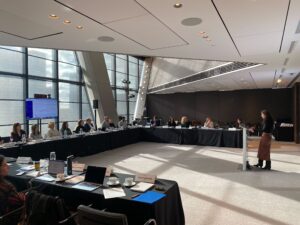When you bring together a room full of forward-thinking legal operations leaders, the conversations get real – fast. At the Priori 2025 Client Advisory Board (CAB) meeting, we heard candid insights about what’s working, what’s not, and what’s keeping legal teams up at night as they plan for the year ahead.
Our CAB members are building sophisticated programs and are driving real change. But they’re also navigating resistance, managing imperfect data, and wrestling with challenges that don’t have obvious solutions.

The questions during Q&As and the casual conversations throughout the day revealed as much as the formal presentations. Here’s what emerged as the defining themes.
What We Heard: The State of Legal Resourcing in 2025
A Reality-Check on AI
If 2022-2025 were the years of AI experimentation, 2026 is the year of accountability. Law firms have spent years investing in technology initiatives and promising transformation, but in-house teams are now asking a harder question: how can you prove it? The gap between promise and proof came up repeatedly.
What we learned? Trust is lagging behind adoption. Younger lawyers are leading the charge on AI tools, but confidence in the outcomes remains mixed. For now, AI is helping law firms boost efficiency and handle more work with existing resources. But, it’s not yet producing the dramatic cost savings that were expected.
Panel Programs Need to Evolve
Preferred firm panels sparked debate at CAB, with members split on whether they deliver meaningful value, or just limit flexibility. The challenge with traditional panels? They push attorneys toward the expensive ‘Tier 1’ firms even for routine work, or get bypassed altogether when the panel structure doesn’t align with the needs of the matter.
The consensus was not to abandon panels entirely, but rather evolve them into dynamic, tiered structures that align firm sophistication to matter complexity. Leading legal departments are adopting tiered models based on risk and complexity, which allows them to stay agile and transparent without red tape. When done right, this panel structure enables faster decisions while keeping costs in check.
Success requires cultural change – attorneys need clear, data-driven criteria that guides decisions rather than restrictive rules that feel like micromanagement.
Getting RFP Buy-in From Attorneys
Even legal departments with formal RFP programs admitted that they struggle with adoption. The challenge? Many lawyers see RFPs as an administrative step rather than a strategic tool. And when firms invest significant effort into proposals without receiving meaningful feedback from in-house teams, the process can feel more like a formality than a tool for better decision-making.
But when RFPs are done well, they work. The legal departments seeing the best results have made their RFP programs structured yet simple to use. They’ve embedded them into the workflow rather than layering them on top. When RFPs simplify decisions rather than create obstacles, they transform from administrative roadblocks into strategic advantages.
Related: 5 Common Mistakes Legal Teams Make After Firm Selection—and How to Avoid Them
Who’s Not Talking (But Should Be)?
One surprising gap that came up repeatedly was between legal operations teams and law firm business development, marketing, and innovation teams. These teams rarely connect directly. Partners talk to in-house attorneys about matters, but the people managing the RFPs, spend, and engagement models rarely speak to their law firm counterparts.
Legal operations teams can articulate what drives value for clients: predictable pricing, streamlined processes, and clear engagement structures.Their counterparts at law firms are actively building programs to deliver on those same priorities. The problem? These conversations are happening through intermediaries or not at all, leaving both sides with incomplete information.
The opportunity here is significant. Direct ops-to-ops dialogue creates more accurate scoping, builds stronger relationships across teams, and creates better alignment on what truly drives value. When both sides understand each other’s constraints and goals, firms can build programs that meet real client needs, while legal departments can articulate their requirements more effectively. Many organizations simply haven’t connected these dots yet.
Embedding Flexible Talent Into Your Strategic Goals
Flexible legal talent is no longer just a temporary solution. Leading legal departments are building centralized programs with the same intensity that they apply to outside counsel management.
Our CAB members agreed that the integration of flex talent is a key determinant of success. Flex professionals struggle when treated like limited contractors, but they deliver when onboarded like employees and given the necessary resources.
When treated as a strategic capability with strong processes, belonging, and data-driven performance metrics, flex talent transforms from a Band-Aid to an operational strength.
What This Means
These key themes point to a fundamental transformation underway in the legal sector. Legal departments are moving away from simple cost control, and are prioritizing strategic value. They are shifting from relationship-driven to data-informed partnerships.
The departments that embrace structure, transparency, and partnership today are defining the future of legal leadership. To succeed, the technology must be embedded directly into the workflow, making good decisions the default – not an administrative challenge.
Looking Ahead
The challenges and opportunities we discussed at CAB are not temporary. They will be the foundation for the next chapter of legal operations. The departments that embrace structure, transparency, and partnership today will be positioned to lead future industry trends. These insights reaffirm the core mission of Priori: to equip legal departments with the essential tools, data, and partnerships required to transition from a reactive function to a strategic one.
Want a closer look? Request a demo to see how we help legal departments streamline sourcing, gain real-time spend visibility, and strengthen law firm relationships through smarter processes.
